Last updated: June 3, 2021
Article
Stratotype Inventory—Sequoia and Kings Canyon National Parks, California
Introduction
Sequoia and Kings Canyon National Parks (SEKI) are contiguous park units in the southern Sierra Nevada in Tulare and Fresno counties, California (Figure 8). Both parks were established in 1890. They encompass a combined area of 350,443 hectares (865,964 acres) with landscapes decorated with huge mountains, rugged foothills, deep canyons, vast caverns, and the world’s largest trees (Anderson 2017). Weather varies greatly by season and elevation in SEKI, which ranges from 418 m (1,370 ft) in the foothills to 4,418 m (14,494 ft) at the summit of Mt. Whitney, the tallest mountain in the contiguous United States. Eleven additional peaks higher than 4,270 m (14,000 ft) are also found in SEKI, forming the crest of the Sierra Nevada along the eastern boundary of the parks. SEKI was designated a Biosphere Reserve in 1978.
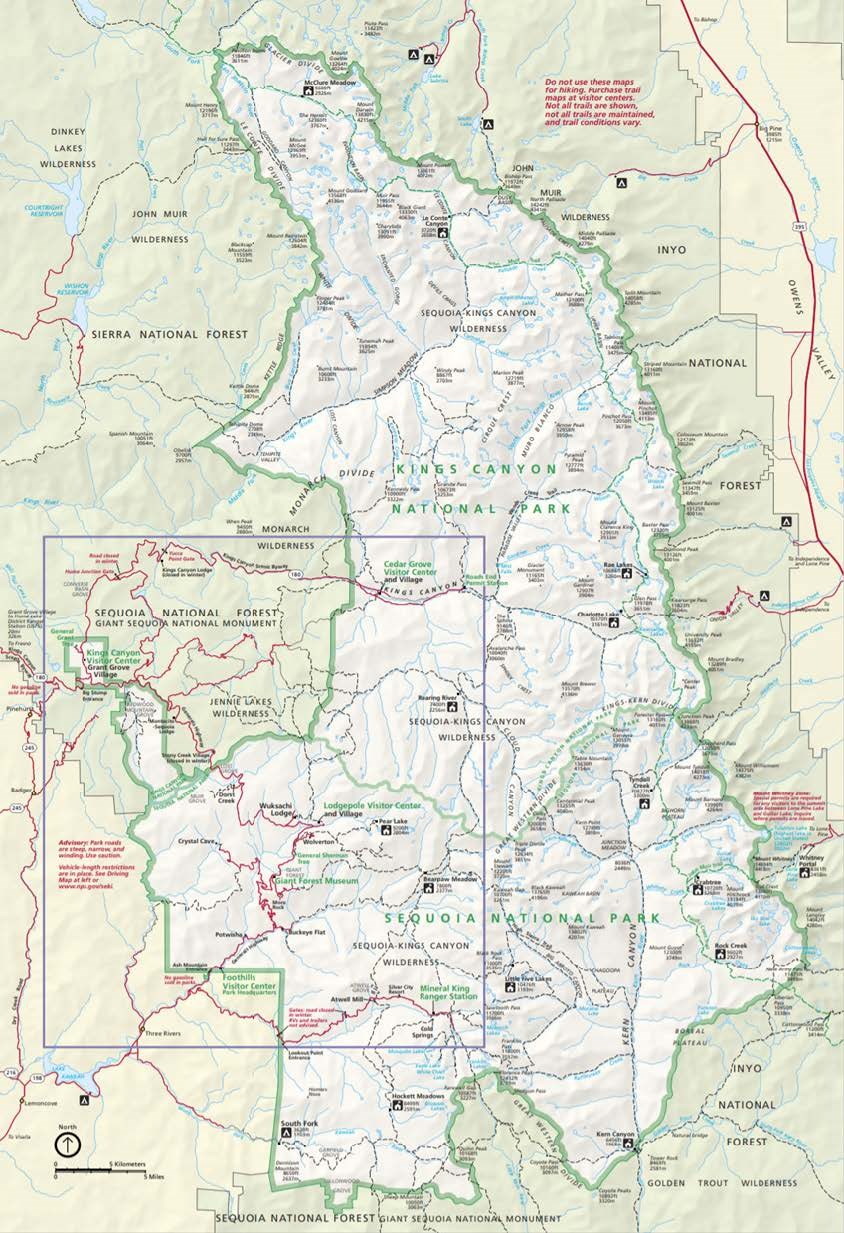
NPS image.
Significance and Geologic Resource Values
The geology of SEKI dominantly consists of Mesozoic igneous rocks associated with the formation of the Sierra Nevada. Numerous geologic units situated within the parks record a complex, episodic emplacement of molten rock that represent the Mount Whitney, John Muir, Mitchell, Sequoia, Shaver, Fine Gold, Palisade Crest, and Scheelite Intrusive Suites (Figures 9 and 10). Isolated areas of SEKI contain older metamorphic rocks that are remnants of volcanic islands tectonically added to North America before the Sierra Nevada uplift. These metamorphic units include metavolcanic rocks, schist, quartzite, phyllite, and marble. Surprisingly, the marble rocks in the parks host more than 270 caves and include the longest cave in California (Lilburn Cave) with nearly 27 km (17 mi) of surveyed passageway. Paleozoic metasedimentary units that occur within SEKI consist of the Cambrian Campito and Poleta formations, as well as the Permian Keeler Canyon, Lone Pine, and Conglomerate Mesa formations. Younger Cenozoic deposits include rhyolites and olivine basalts, in addition to glacial till deposits from Pleistocene glaciers responsible for carving out deep, spectacular canyons that include Kings Canyon.

NPS image.

NPS image.

NPS image.
Stratotypes in Sequoia and Kings Canyon National Parks
The boundaries of SEKI contain 12 stratotypes that are associated with the formation of the Sierra Nevada batholith. These stratotypes are subdivided into eight type localities and four type areas (Table 1; Figure 11).
| Unit Name (map symbol) | Reference | Stratotype Location | Age |
|---|
Geologic Time Scale
Location Map
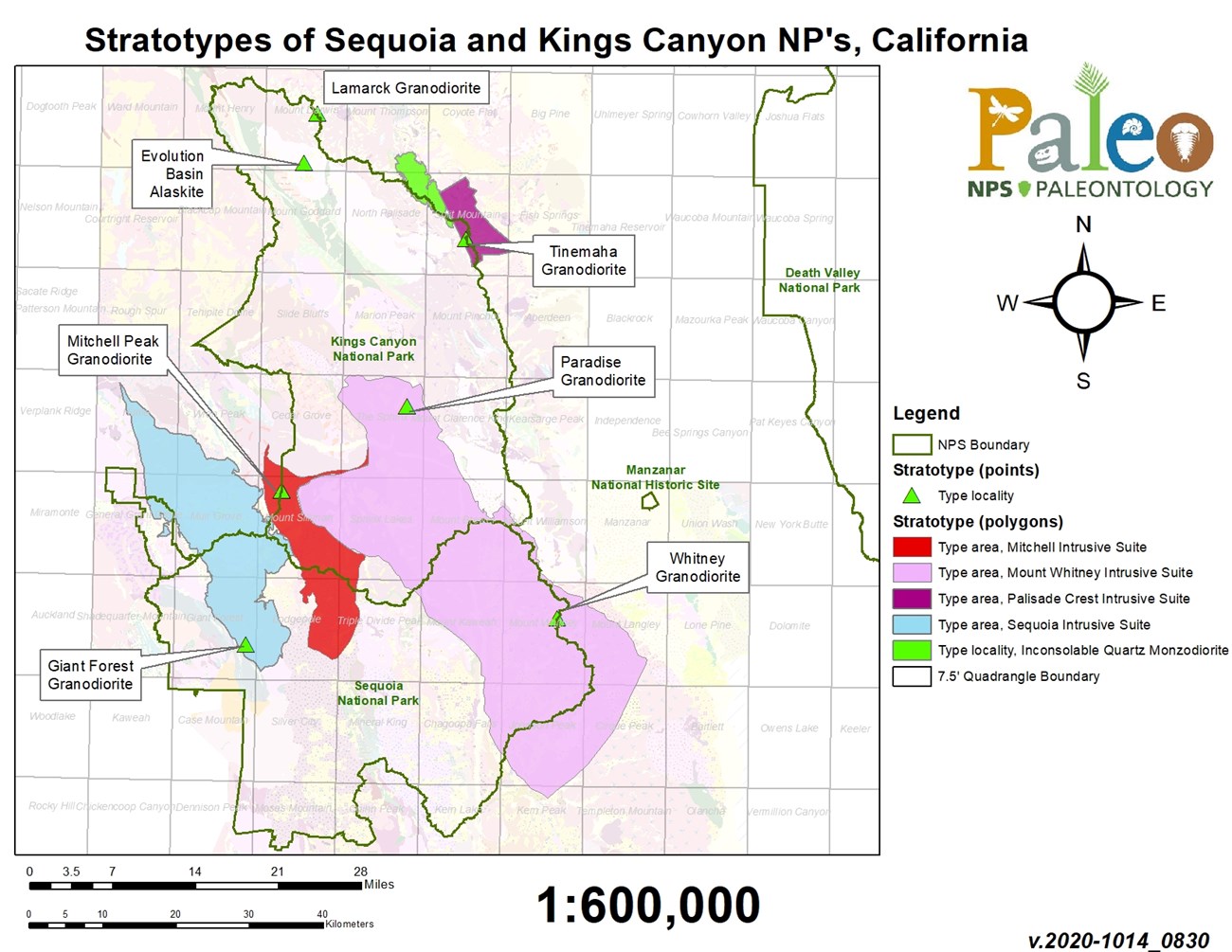
NPS image.
The oldest designated stratotype in SEKI pertains to the Jurassic Tinemaha Granodiorite of the Palisade Crest Intrusive Suite. The granodiorite was named by Bateman (1961) after Mount Tinemaha, near the eastern border of Kings Canyon National Park. Type locality exposures are designated in the cirques at the head of Tinemaha Creek, in the cliffs of Mount Bolton Brown (Figure 11; Bateman 1961). Other notable exposures occur in the summits of Split Mountain, Mount Tinemaha, Birch Mountain, and The Thumb (Figure 12). The granodiorite is characterized as porphyritic with feldspar grains up to 1.5 cm (0.6 in) and containing numerous lenticular mafic inclusions rich in biotite and hornblende (Bateman 1961, 1992). The main outcrop area of the Tinemaha Granodiorite occurs as an 83 km2 (32 mi2) oval-shaped mass that is bisected by the granodiorite of McMurry Meadows (Bateman 1961, 1992). Exposures of the unit are nearly identical in appearance, with only minor differences in texture and color index.
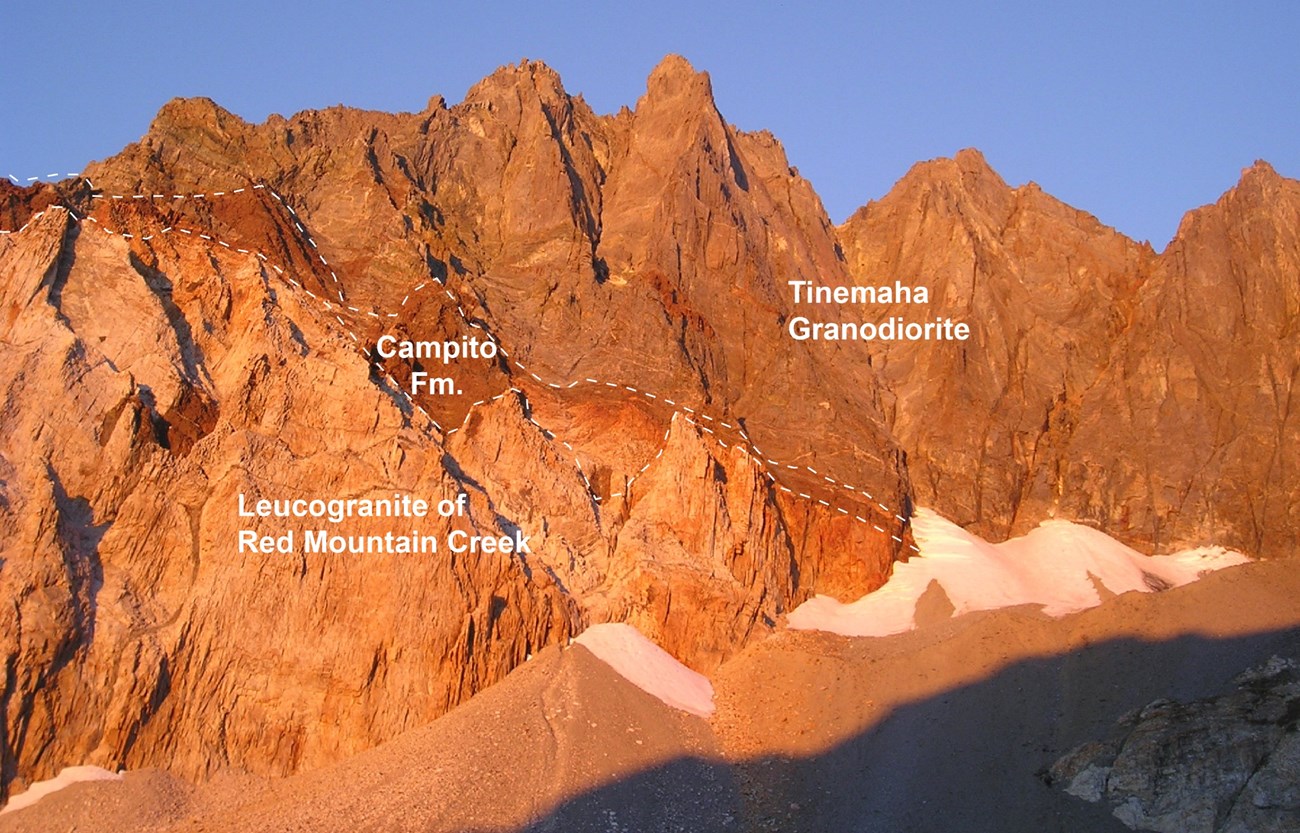
Image modified from Bartley et al. 2012.
The Jurassic Palisade Crest Intrusive Suite was originally referred to as the Palisade Crest sequence by Bateman and Dodge (1970) and was formally named for exposures along and west of Palisade Crest, part of the Sierra Nevada divide west of Big Pine, California (Bateman 1992). Bateman (1992) states that the type area is located in the eastern escarpment of the Sierra Nevada from Big Pine Creek south to Red Mountain Creek (Figure 11). The suite consists of at least two intrusive units, the Tinemaha Granodiorite and the granodiorite of McMurry Meadows, but also probably includes the leucogranites of Red Mountain and Taboose Creeks (Bateman 1992). The younger granodiorite of McMurry Meadows is nested within the Tinemaha Granodiorite (Bateman 1961, 1992).
The Cretaceous Inconsolable Quartz Monzodiorite was originally named the Inconsolable Granodiorite by Bateman (1961) after its type locality in the Inconsolable Range (Figure 11). The main pluton mass of the unit forms an elongate body in a northwesterly direction and has an outcrop area of approximately 32.4 km2 (12.5 mi.2) (Bateman 1961, 1992). Exposures of the monzodiorite can be found along the northeastern boundary of Kings Canyon National Park in the region from the Middle Palisade to Mount Agassiz. Spectacular cirques found at the heads of the North and South forks of Big Pine Creek are carved into the Inconsolable Quartz Monzodiorite (Bateman 1961). The unit is characterized as a medium grained, medium-gray quartz monzodiorite with a high average mafic mineral content that includes biotite, hornblende, and augite (Bateman 1961, 1992).
The Cretaceous Giant Forest Granodiorite of the Sequoia Intrusive Suite was informally termed the Giant Forest pluton by Ross (1958) and formally named by Moore and Sisson (1987) after Giant Forest, located in both the Triple Divide Peak and Giant Forest quadrangles, California. Moore and Sisson (1987) state the type locality of the unit is at Moro Rock, just south of Giant Forest in the Giant Forest 15’-quadrangle (Figures 11, 13, and 14). Exposures of the Giant Forest Granodiorite occur over a broad area in both quadrangles, and the rock is characterized as a hornblende-rich granodiorite that contains abundant mafic inclusions. Uranium-lead dating by Chen and Moore (1982) indicate the unit is approximately 102–97 million years old.
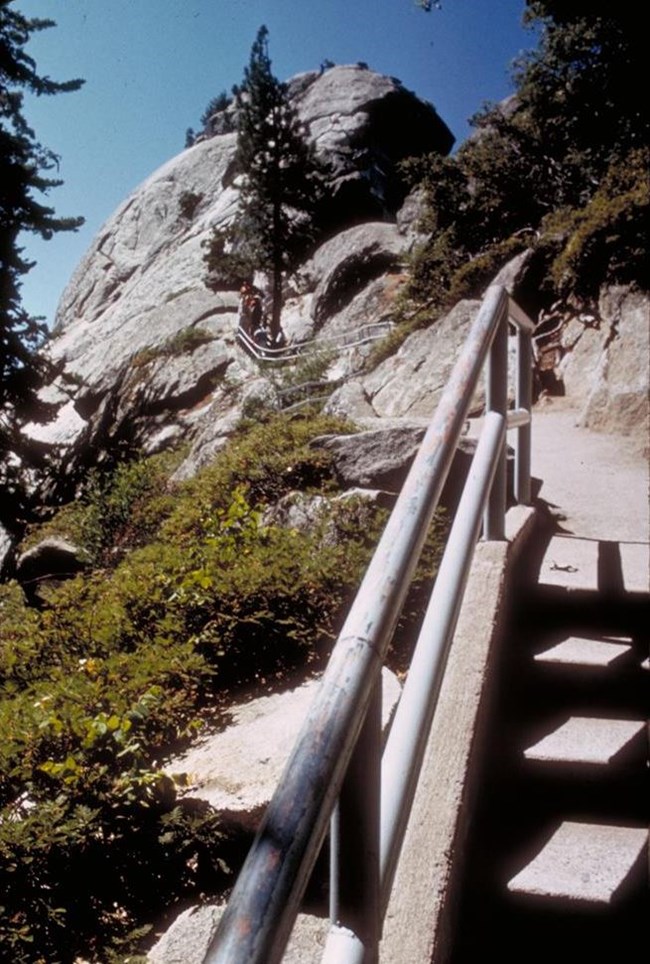
NPS photo.
The Cretaceous Sequoia Intrusive Suite was formally named by Moore and Sisson (1987) after Sequoia National Park. The type area of the Sequoia Intrusive Suite is in the Shell Mountain–Little Baldy area in the Giant Forest 15’ quadrangle, California (Figure 11; Moore and Sisson 1987). Units that comprise the suite include the Giant Forest Granodiorite (oldest unit) and three younger, smaller plutons: the granite of Big Meadows, granodiorite of Clover Creek, and the granite of Weaver Lake (youngest unit). These four units show that the intrusive suite is compositionally zoned, with granodiorite at the margins and leucogranite located in the core (Bateman 1992). Most of the U-Pb ages from samples of the Sequoia Intrusive Suite reported in Chen and Moore (1982) are approximately 102.3 to 96.3 million years old.
The Cretaceous Mitchell Peak Granodiorite of the Mitchell Intrusive Suite was informally referred to as the granodiorite of Mitchell Peak by Moore (1978, 1981) and formally renamed by Moore and Sisson (1987). The unit is named after its type locality exposures that occur on the summit of Mitchell Peak in SEKI (Figure 11). The granodiorite is the most extensive unit of the Mitchell Intrusive Suite, covering an area approximately 32 km (19.9 mi) long and 13 km (8 mi) wide. Moore and Sisson (1987) describe two distinct facies that comprise the unit: 1) a younger, more dominant fine-grained, porphyritic facies with plagioclase feldspar phenocrysts (mineral crystals) 2–4 cm (0.8–1.6 in) length; and 2) an older, coarse-grained, porphyritic facies with alkali feldspar phenocrysts 3–4 cm (1.2–1.6 in) in length. The type locality, designated at the summit of Mitchell Peak, consists of the fine-grained facies (Moore and Sisson 1987).
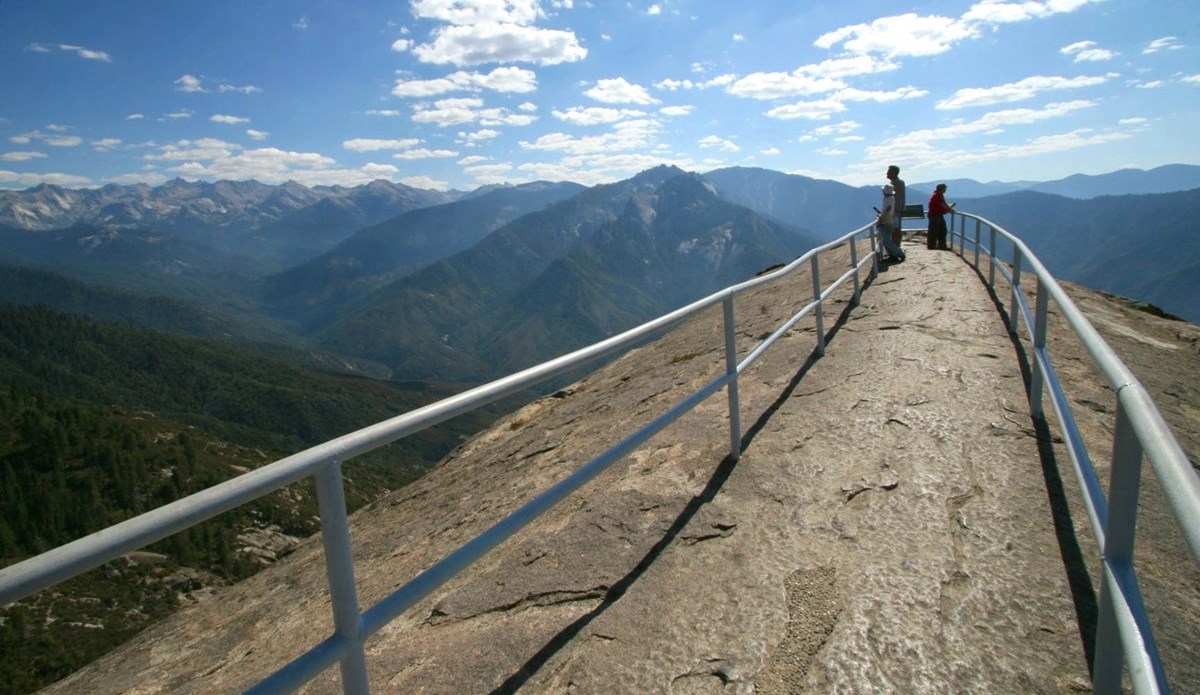
NPS photo.
The Cretaceous Mitchell Intrusive Suite was originally named by Moore and Sisson (1987) after Mitchell Peak, SEKI and occupies much of the central part of the Triple Divide Peak quadrangle, California. Moore and Sisson (1987) state that the type area for the suite is the Tableland area on the divide between the Kings and Kaweah Rivers, SEKI (Figure 11). Members of the suite include the granodiorite of the Castle Creek (oldest unit), granodiorite of Lookout Peak, and the Mitchell Peak Granodiorite (youngest unit).
The Upper Cretaceous Paradise Granodiorite of the Mount Whitney Intrusive Suite was informally referred to as the Paradise pluton by Moore (1963, 1978) before being formally renamed by Moore (1981) after its type locality on the east side of Paradise Valley in the east-central Marion Peak quadrangle, California (Figure 11). The nested sequence of the Paradise Granodiorite and the Cretaceous Whitney Granodiorite represents one of the largest and youngest granitic sequences in the Sierra Nevada, covering an area 1,100 km2 (425 mi2). The Paradise Granodiorite is believed to have been emplaced as a single intrusion about 85 million years ago (Moore 1981). The unit is characterized as a porphyritic granodiorite with minor granite that contains potassium feldspar phenocrysts with abundant, zoned inclusions of biotite and hornblende (Moore 1978).
The Upper Cretaceous Lamarck Granodiorite of the John Muir Intrusive Suite was named by Bateman (1961) after Mount Lamarck in SEKI. Excellent exposures that occur east of Mount Lamarck constitute the type locality (Figure 11; Bateman 1961). The granodiorite is the oldest unit of the John Muir Intrusive Suite (approximately 90 million years old) and forms a lenticular-shaped pluton approximately 60 km (37 mi) long and 10 km (6 mi) wide (Bateman 1992). The unit is characterized as a medium-grained, porphyritic granodiorite that contains biotite and hornblende that occur as both clusters and discrete crystals (Bateman 1992).
The Upper Cretaceous Evolution Basin Alaskite of the John Muir Intrusive Suite was informally referred to as the Alaskite of Evolution Basin and LeConte Canyon by Bateman and Moore (1965) and the leucogranite of Evolution Basin by Stern et al. (1981) before being formally named by Bateman (1992). Bateman (1992) designated exposures in Evolution Basin, SEKI as the type locality (Figures 11 and 15). The Evolution Basin Alaskite is described as an extremely felsic, light-colored, medium- to fine-grained alaskite that forms a lenticular igneous body approximately 30 km (19 mi) long and 6 km (4 mi) wide.
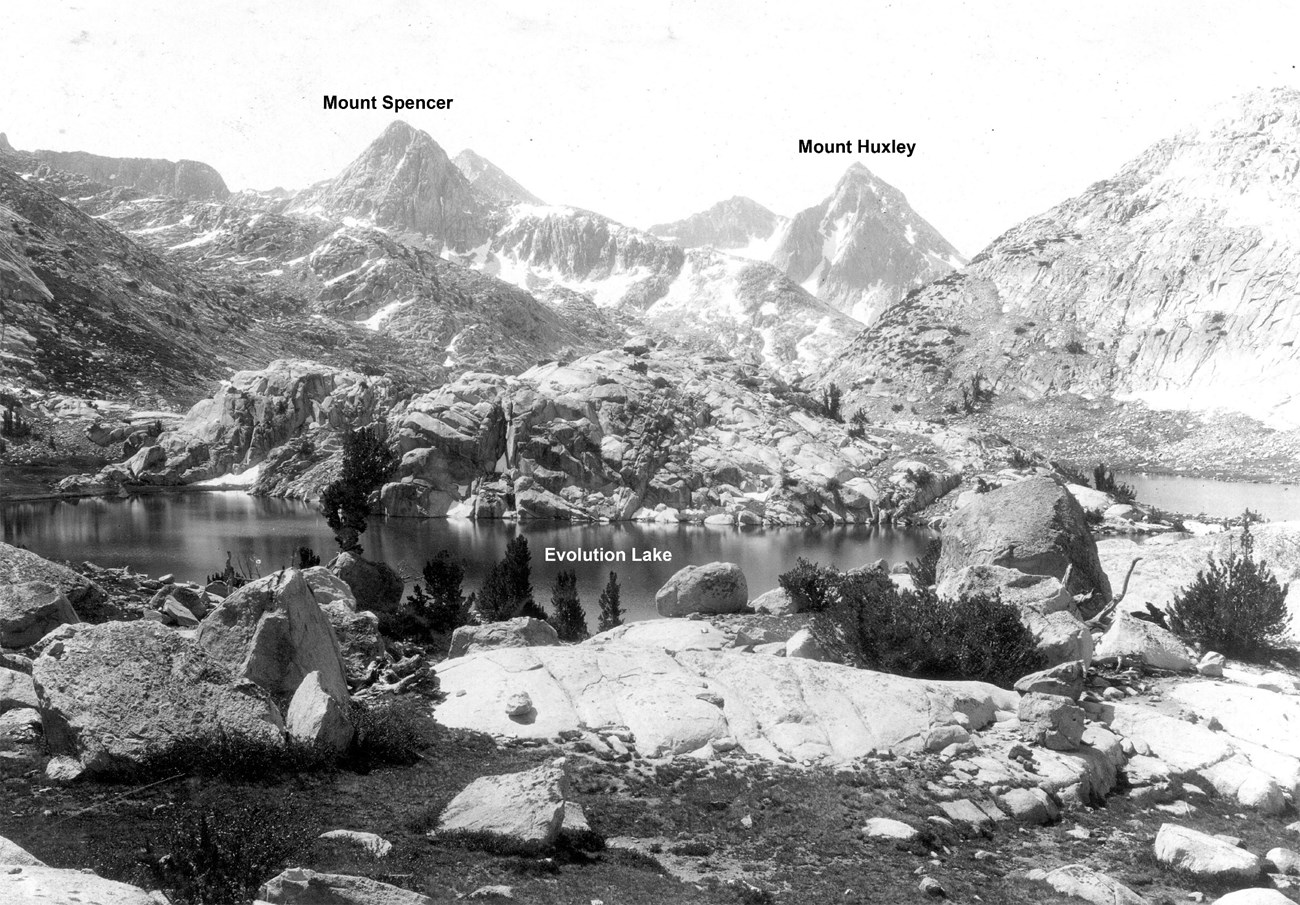
USGS image.
The Upper Cretaceous Whitney Granodiorite of the Mount Whitney Intrusive Suite was formally named by Moore (1981) after Mount Whitney, SEKI. Exposures that occur 200 m (660 ft) north of the summit of Mount Whitney are designated the type locality (Figures 11 and 16; Moore 1981). The unit is described as a porphyritic granodiorite and granite with a domical pluton profile that contains large phenocrysts of potassium feldspar 4–8 cm (1.6–3.0 in) in length and an average potassium-argon age of 83 million years old (Moore 1981).
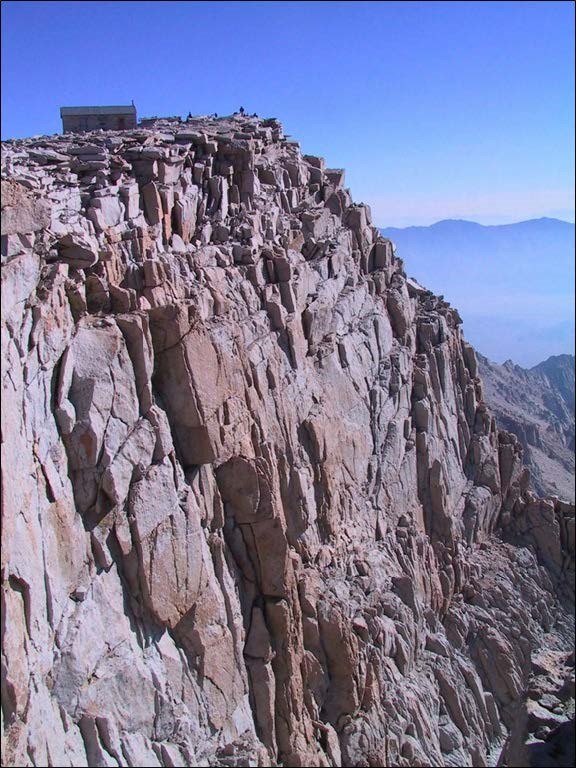
NPS photo.
The Upper Cretaceous Mount Whitney Intrusive Suite was originally named for Mount Whitney by Moore and Sisson (1987). The type area of the suite is located along the Sierra Nevada crest near Mount Whitney (Figure 11; Moore and Sisson 1987). Members of the suite include the granodiorite of Sugarloaf (oldest unit), the Paradise Granodiorite, and the Whitney Granodiorite (youngest unit). The Mount Whitney Intrusive Suite represents one of the youngest granitic sequences of the Sierra Nevada, extending approximately 83 km (52 mi) southeastward from the central part of the Marion Peak 15’ quadrangle on the northwest to the southeastern part of the Olancha 15’-quadrangle on the southeast (Moore and Sisson 1987).
In addition to the designated stratotypes located within SEKI boundaries, a list of stratotypes located within 48 km (30 mi) of park boundaries is included here for reference. These nearby stratotypes include
- Cambrian
- Poleta Formation (type section)
- Andrew Mountains Member of the Campito Formation (reference section)
- Permian
- Lone Pine Formation (type locality)
- Reward Conglomerate Member of the Lone Pine Formation (type section)
- Conglomerate Mesa Formation (type section)
- Pennsylvanian–Permian
- Keeler Canyon Formation (type locality)
- Triassic
- Scheelite Intrusive Suite (type area)
- Wheeler Crest Granodiorite (type locality)
- Union Wash Formation (type section and type locality)
- Tungsten Hills Granite (type locality)
- Cretaceous
- John Muir Intrusive Suite (type area)
- Lake Edison Granodiorite (type locality)
- Round Valley Peak Granodiorite (type locality)
- Mount Givens Granodiorite (reference locality)
- Shaver Intrusive Suite (type area)
- Dinkey Creek Granodiorite (type locality)
- Pleistocene
- Bishop Tuff (type locality)
- Tenaya Till (type locality)
- Sherwin Till (type locality)
- Recess Peak Till (type locality)
Type Section Inventory Report—Sierra Nevada Inventory & Monitoring Network

The information on this page is excerpted from a report covering three parks within the Sierra Nevada Inventory and Monitoring Network (SIEN):
The full Network report is available in digital format from the Sierra Nevada Inventory and Monitoring Network and Natural Resource Publications Management websites. To receive this report in a format optimized for screen readers, please email irma@nps.gov.
Please cite this publication as:
- Henderson T, Santucci VL, Connors T, Tweet JS. 2021. National Park Service geologic type section inventory: Sierra Nevada Inventory & Monitoring Network. Natural Resource Report. NPS/SIEN/NRR—2021/2219. National Park Service. Fort Collins, Colorado. https://irma.nps.gov/DataStore/Reference/Profile/2284063
Leave No Trace—Protect Type Sections for Science

Many type sections and paleontological sites are vunerable to damage from careless visitation and over-use. Be sure to practice Leave No Trace princples whenever you are in the outdoors. Of particular importance at geoheritage sites is to:
-
Travel and camp on durable surfaces, and
-
Leave what you find.
If you see signs of vandalism or someone acting inappropriately during your visit to a park site, please contact a ranger at the park or make a report through NPS Investigative Services.
Related Links
- Sequoia and Kings Canyon National Parks, California—[Geodiversity Atlas] [Park Home] [NPSHistory.com]
- Geologic Time Scale
- America's Geoheritage
- NPS Paleontological Resource Inventory
- NPS Geologic Resources Inventory
- NPS Geodiversity Atlas
